
The codex was the historical ancestor of the modern book. Instead of being composed of sheets of paper, it used sheets of vellum, papyrus, or other materials. The term codex is often used for ancient manuscript books, with handwritten contents. A codex, much like the modern book, is bound by stacking the pages and securing one set of edges in a form analogous to modern bookbinding by a variety of methods over the centuries. Modern books are divided into paperback or softback and those bound with stiff boards, called hardbacks. Elaborate historical bindings are called treasure bindings. At least in the Western world, the main alternative to the paged codex format for a long document was the continuous scroll, which was the dominant form of document in the ancient world. Some codices are continuously folded like a concertina, in particular the Maya codices and Aztec codices, which are actually long sheets of paper or animal skin folded into pages.

Jean Grolier de Servières, viscount d'Aguisy was Treasurer-General of France and a famous bibliophile. As a book collector, Grolier is known in particular for his patronage of the Aldine Press, and his love of richly decorated bookbindings.
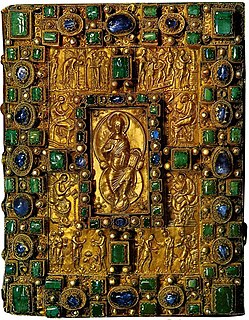
A treasure binding or jewelled bookbinding is a luxurious book cover using metalwork in gold or silver, jewels, or ivory, perhaps in addition to more usual bookbinding material for book-covers such as leather, velvet, or other cloth. The actual bookbinding technique is the same as for other medieval books, with the folios, normally of vellum, stitched together and bound to wooden cover boards. The metal furnishings of the treasure binding are then fixed, normally by tacks, onto these boards. Treasure bindings appear to have existed from at least Late Antiquity, though there are no surviving examples from so early, and Early Medieval examples are very rare. They were less used by the end of the Middle Ages, but a few continued to be produced in the West even up to the present day, and many more in areas where Eastern Orthodoxy predominated. The bindings were mainly used on grand illuminated manuscripts, especially gospel books designed for the altar and use in church services, rather than study in the library.
Queens' Binder is the name given to a small group of English bookbinders active during the Restoration period, often called the "Golden Age of English Bookbinding".
John Ratcliff of the seventeenth century is the first identifiable bookbinder in America, known for binding Eliot's Indian Bible in 1663. Ratcliff, who came from London, England, worked as a bookbinder in Boston, Massachusetts, for about twenty years, from approximately 1662 to 1682.
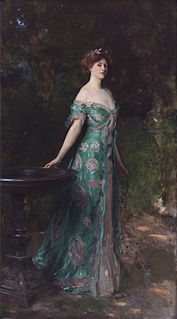
Millicent Sutherland-Leveson-Gower, The Duchess of Sutherland RRC was a British society hostess, social reformer, author, editor, journalist, and playwright, often using the pen name Erskine Gower. Her first husband was Cromartie Sutherland-Leveson-Gower, 4th Duke of Sutherland. By her two later marriages, she was known as Lady Millicent Fitzgerald and Lady Millicent Hawes, the latter of which was the name she used at the time of her death.
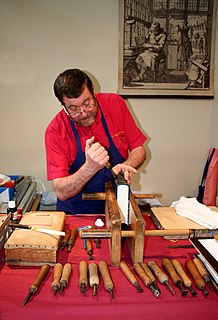
Bookbinding is the process of physically assembling a book of codex format from an ordered stack of paper sheets that are folded together into sections called signatures or sometimes left as a stack of individual sheets. Several signatures are then bound together along one edge with a thick needle and sturdy thread. Alternative methods of binding that are cheaper but less permanent include loose-leaf rings, individual screw posts or binding posts, twin loop spine coils, plastic spiral coils, and plastic spine combs. For protection, the bound stack is either wrapped in a flexible cover or attached to stiff boards. Finally, an attractive cover is adhered to the boards, including identifying information and decoration. Book artists or specialists in book decoration can also greatly enhance a book's content by creating book-like objects with artistic merit of exceptional quality.
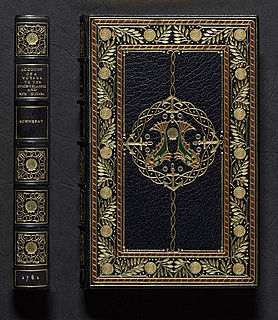
Sangorski & Sutcliffe is a firm of bookbinders established in London in 1901. It is considered to be one of the most important bookbinding companies of the 20th century, famous for its luxurious jeweled bindings that used real gold and precious stones in their book covers.
Jean Picard was a French bookbinder, active around 1540. Picard is notable for having bound many books for the bibliophile Jean Grolier. He may also have worked at the French royal bindery.
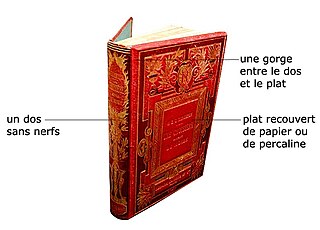
A Bradel binding is a style of book binding with a hollow back. It most resembles a case binding in that it has a hollow back and visible joint, but unlike a case binding, it is built up on the book. Characteristic of the binding is that the material covering the outside boards is separate from that covering the spine. Many bookbinders consider the Bradel binding to be stronger than the Case binding.

The British Library contains a wide range of fine and historic bookbindings; however, books in the Library are organised primarily by subject rather than by binding so the Library has produced a guide to enable researchers to identity bindings of interest. The collection includes the oldest intact Western bookbinding, the leather binding of the 7th century St Cuthbert Gospel.
Thomas Mahieu, also known as Thomas Maiolus, was a French courtier and bibliophile with a special interest in decorative bookbindings.
Katharine Adams was a British bookbinder famous for her detailed leather bindings.
Claude de Picques was an influential French bookbinder. He was closely connected with the court of King Henry II of France, serving as the personal bookbinder to Queen Catherine de' Medici from 1553 and as the personal bookbinder to the King himself from 1556 to 1574. He is thought also to have been one of the binders who worked for Thomas Mahieu.
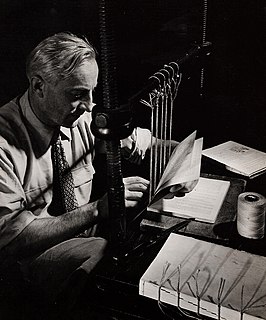
George A. Baer was a German/Swiss/American bookbinder. He specialized in fine leather bindings, including inlays and gold tooling.
Sybil Pye was a self-trained British bookbinder famous for her distinctive inlay Art Deco leather bindings. She was, along with Katharine Adams and Sarah Prideaux, one of the most famous women bookbinders of their period. She was the only binder in England and one of a few in the world whose specialty was inlaid leather bindings.
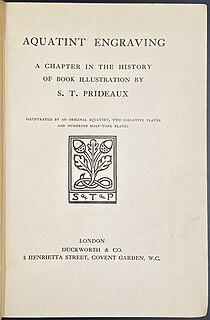
Sarah Prideaux was a bookbinder, teacher, historian and author of books on binding and illustration. She, along with Katharine Adams and Sybil Pye, was one of the noted women bookbinders of the period.
Annie S. Macdonald (1849-1924) was an artistic bookbinder from Scotland, active in the 1890s and the early 20th century. She was known for her study of old binding techniques, determining how book bindings were created in the medieval era and duplicating the methods used.
Christine Elizabeth Florence Greenhill was an English bookbinder. She did bookbinding following her encouragement from her sister to enrol on bookbinding classes until the Second World War broke out when she became a full-time air raid warden and thus had little time to do bookbinding. Greenhill returned to bookbinding soon after the war was over and served as honorary secretary of the Guild of Contemporary Bookbinders before being elected its president for a single term. The Bodleian Library has held two collections of boxes relating to her life and career in its Libraries Repository since 2009.

Andrew Barclay (1737–1823) was a Scottish bookbinder who emigrated from Kinross, Fifeshire, to Boston in the British-American colonies in the mid-eighteenth century. As the American Revolutionary War drew near, Barclay sided with the Loyalists and was compelled to leave Boston when the British were driven out in March 1776. Upon leaving Boston he was assigned a command in charge of getting Loyalist refugees out of Boston to Nova Scotia. Soon after, he continued his trade in British-occupied New York for the duration of the war. Bookbinder's trade labels like Barclay's, found on the inside cover of some of his works, are considered a rarity among books printed in colonial America.











